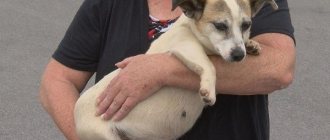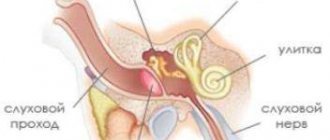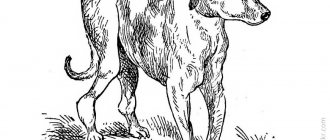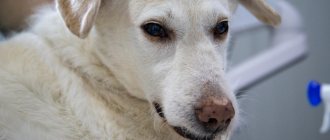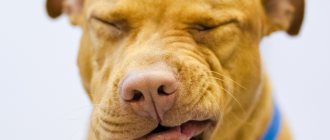Why does a dog cough?
The causes of cough in dogs can be very diverse. Conventionally, they can be divided into two groups: those associated with diseases of internal organs and household ones. Among the first are often found:
- bacterial, viral, fungal infections of the nasopharynx, respiratory tract, lungs;
- heart diseases;
- allergies;
- neoplasms;
- helminthiases.
Factors of the second group that provoke a cough reflex in an animal include the following.
Check to see if the collar is too tight on your dog's throat - this may be the cause of the cough.
- Tight collar. The dog coughs when it is over-tightened (“so as not to run away”), if the collar has become small, while the leash is being pulled. The latter is especially typical for young, overly active pets. Coughing is often associated with a leash in dogs with too short or, conversely, long necks. In the first case, it is preferable to use a harness, and in the second, carefully select the width of the accessory.
- Accumulation of hair in the esophagus and stomach. The problem is typical for four-legged animals with long hair. When licking (although not frequently), the dog involuntarily swallows hair, which does not move along the digestive tract, but gradually collects in a lump in the stomach or esophagus. Such accumulations lead to a gag and cough reflex. At the same time, the dog coughs as if he was choking.
- A foreign object is stuck in the throat. Anything can get stuck: a thread, New Year's rain, a fish bone, a chicken bone. The thread, if it is not completely swallowed, will irritate the mucous membrane of the oropharynx and esophagus for a long time, causing coughing and vomiting. Sharp bones, piercing the tissues of the oral cavity, pharynx, and esophageal wall, not only create a feeling of interference in the animal, but also lead to inflammatory processes (suppuration, pain, swelling of the mucous membrane, etc.).
- Features of the anatomical structure of the pet's respiratory tract, oropharynx and esophagus. Short-faced animals are characterized by the so-called reverse sneezing. This is a paroxysmal cough, not associated with diseases, that occurs suddenly and passes quickly, without outside help.
Games on feelings
In real veterinary clinics there will be elements of “divorce”.
Veterinarians say that this is often determined by the client’s wallet. The greater the opportunity to pay for services and the more the owner worries about his pet, the more likely the animal will be prescribed additional immunostimulants, dietary supplements, water-soluble and fat-soluble vitamins, and special food. There are cases when this is really necessary (pedigreed, show animals, weakened after a serious illness). But it will be good if you ask your veterinarian in detail about the need for each appointment. Find out in detail about the results of the examination and analysis of your pet’s condition. Be persistent. Do not give in to attempts to intimidate you, be consistent in your questions. Consult a specialist who does not work at this veterinary clinic. If it turns out that half of the prescriptions are prescribed to enrich the veterinarian’s pocket, and not for the health of the animal, feel free to leave. And do not forget to leave a negative review about the organization - other owners may also suffer.
Types of cough in dogs
Cough in dogs is classified based on several characteristics. It is important that the owner, when contacting a veterinary clinic, can talk about each of them in sufficient detail.
Parameter
Type of cough
Presence/absence of sputum
- Wet (with mucus)
- Dry (without it)
Character of the course
- Acute (appears sharply, pronounced)
- Subacute (develops progressively, gradually intensifying)
- Chronic (lasts a long time)
Severity of manifestation
- Minor
- Strong
- Paroxysmal
Cough frequency
- Rare
- Frequent
In addition, there is a seasonal cough - an allergic reaction of the pet’s body to changes in nature.
Heart diseases
A cough can indicate not only respiratory diseases, but also a canine heart disease. In addition to coughing, symptoms such as:
- labored breathing;
- weakness, drowsiness;
- lack of appetite;
- blue discoloration of mucous membranes;
- open mouth when breathing, as if the animal does not have enough air coming through the nose. This happens especially often in hot weather;
- The cough most often occurs at night or in the morning.
In order to make an accurate diagnosis, you need to go to a veterinary clinic. After the examination, the veterinarian will prescribe medications to normalize heart function, to maintain uniform breathing, and will tell you what to give and what to do if an attack occurs. If heart disease is accompanied by edema, then diuretics are prescribed.
Associated symptoms
Coughing in dogs can occur on its own or be accompanied by other symptoms. Among them:
- vomit;
- blood in sputum;
- foamy discharge from the mouth;
- temperature increase;
- refusal of food;
- muscle weakness (the animal has difficulty moving);
- breathing problems, shortness of breath, and so on.
Some diseases develop rapidly and can lead to the death of your pet. If your dog's condition suddenly worsens, you should immediately contact a veterinarian.
Important points
- Refusal to vaccinate. This is dangerous for the animal and all those who will come into contact with it (people). Vaccination is a scientifically proven method of preventing many infectious diseases. Get your animal vaccinated by a trusted veterinarian (or with his approval yourself). It is important to get vaccinated against rabies - this is a fatal disease induced by the Rabies lyssavirus virus, which cannot be cured, but can be prevented.
- Anesthesia - inhalation, intravenous, anesthesia - epidural, conduction. They are necessary so that the animal does not suffer, to prevent painful shock. The veterinarian’s “hands on” are important here - both overdose and weak anesthesia lead to serious consequences (shock, poisoning, death) for the animal.
- Sterility, antiseptic. If you see that the veterinarian does not follow the rules of antiseptics (reuses disposable syringes, diapers, bandages, does not treat hands with antiseptic after contact with the previous animal), the best choice would be to contact another veterinarian.
- Important medicines:
- Antibiotics - amoxicillin, tilozil, trimethoprim, sulfadiazine, lincomycin, marbofloxacin;
- Antipyretics - paracetamol, salicylic acid preparations, antipyrine, butadione, amidopyrine;
- Anti-inflammatory drugs - vedaprofen, choline salicylate cycloferon, aspirin;
- Anesthetics - novocaine, lidocaine, dicaine, trimecaine;
- Hemostatics - fibrinogen, thrombin, vikasol, phytomenadione, calcium chloride, etamsylate;
- Antiparasitic - praziquantel, aversectin, albendazole, ivermectin, fluralaner.
If you care what happens to your pet, you should not neglect appointments.
Don't let unverified veterinary clinics endanger your pet and profit from their owner's feelings! If you have time and desire, it is worth trying to achieve justice in case of violation of ethical or legal standards.
Diagnosis of cough in a dog
A dog's cough can cause serious illness, so it is recommended that you take your pet to see a veterinarian.
At the veterinarian's appointment, the pet will be examined and the owner will be questioned. It will be necessary to talk about the characteristics of the cough, its duration, and the conditions accompanying its occurrence. You will need to provide information about the dog’s age, the presence of any diseases, vaccinations, living conditions, etc. The complex of diagnostic procedures may include methods such as:
- X-ray;
- bronchoscopy;
- ECG;
- cytological, bacteriological examination of sputum.
Choosing a veterinary clinic
We determine the veterinary clinic where you plan to go. A big PR company doesn't promise quality. The price is explained by the huge amount of money invested in advertising and “signboarding” of the establishment.
It’s great if you can ask your friends about clinics where their pets were treated “humanely.” If you travel far from them, it may be worth sacrificing time for the health of your pet.
A few more tips on how to spot an unverified veterinary clinic:
- Refusal to provide certificates and licenses for veterinary activities.
- Strange and suspicious behavior of the veterinarian (inconsistency, flattery, attempts to intimidate, shouting).
- Prices are too low (compared to other organizations).
- Refusal to freely visit the veterinary clinic.
“We have a sanitary day”
Beware of scammers!
When you contact the veterinary clinic, you are informed: “we cannot accept you at this address, sanitary day/repair/inspection.” How much intelligence does a dispatcher have? The client is persuaded to have a veterinarian come to his home. The price does not change.
A veterinary clinic can exist purely nominally. And the invited “Aibolit” will not bear responsibility. There is a high probability of running into a person without a veterinary diploma or simply an unprofessional.
It is better to find time to visit the veterinary clinic on your own. This is safer for the animal.
Cough when a foreign body enters the respiratory tract
As a rule, if a dog chokes or swallows something extra, it copes with the situation on its own by coughing up. At such a moment, the cough begins suddenly, sharply, accompanied by corresponding movements of the neck and head, and a characteristic posture.
There may be another situation: the animal choked on a sharp bone, an object that, due to its shape or size, got caught in the mucous membrane. Then the following symptoms may appear:
- cough in fits and starts, prolonged, debilitating;
- during the cough reflex, the pet tries to push the foreign body out of the throat;
- wheezing;
- difficulty breathing;
- foam from nostrils;
- cough with blood, foam;
- refusal to drink and eat.
You cannot hope that the dog will cope on its own. Trying to pull out (or even see) what got into her throat is almost impossible without special tools. The animal needs to be taken to the clinic urgently. Delay threatens the development of emphysema, inflammatory processes in the bronchi, lungs, pleura and other complications.
How to find out the truth
Another possible way for veterinarians to make dishonest money is to conceal the diagnosis. Let's say a veterinarian discovers a malignant tumor in a cat. But if he says that the tumor is benign and treatable. A housewife who dotes on her pet will give money for already useless procedures, medications and surgical interventions.
The veterinarian may deliberately “downplay” the diagnosis in order to earn more money. If something doesn't add up, insist on clarification. There is no need to be intimidated by unfamiliar terms - take a short break and try to find information on the Internet.
You are free to leave (or threaten to do so) to another clinic at any time.
Make sure that the veterinary clinic is honest - get tested in an independent laboratory.
Justice
What to do if an animal was injured as a result of unprofessional actions of a veterinarian:
- Write an official complaint addressed to the head of the clinic.
- File a complaint with the city veterinary department.
- You can contact Rospotrebnadzor.
- Contact a lawyer for help
The Law “On the Protection of Consumer Rights” and Article 245 of the Criminal Code “Cruelty to Animals” are the grounds for considering claims regarding the work of veterinary clinics.
Aviary (kennel) cough in a dog
Aviary cough is a symptom of some infectious (mainly viral) diseases of dogs, so named because of the most common cause of infection - living together or frequent contact of animals with each other. The source of infection is a sick or recovering dog.
Signs of the disease are determined by the characteristics of the pathogen (parainfluenza, canine herpes, bordetella), as well as the state of the animal’s immune system. After the incubation period (up to 10 days) has passed, the following manifestations of pathology are possible:
- a slight paroxysmal cough, similar to the dog choking, but less pronounced;
- cough with white foam;
- swollen lymph nodes;
- increase in temperature indicators;
- lacrimation;
- discharge from the nostrils.
Kennel cough lasts approximately 2 weeks. The stronger the dog’s immunity, the easier it tolerates the infection, sometimes without even requiring special treatment. In severe cases, the use of antibacterial, antiviral, expectorant, immunomodulatory and other agents is indicated (based on examination results).
Prepare before going to the vet
In the office, you may have to provide the veterinarian with all possible assistance (hold the animal while they take blood for analysis, give an injection, extinguish aggression, calm your voice, scratch its ears, stroke it). If you know that you are terrified of blood, IVs, or definitely cannot withstand the type of medical interventions, then perhaps you should ask a friend or relative for help.
Find a veterinary certificate, veterinary passport.
Take:
- Leash;
- Collar;
- Muzzle;
- Carrying;
- A pack of napkins;
- litter;
- Bowl, water (at the veterinarian's discretion)
Prepare answers to possible questions from the veterinarian:
https://dog-care.ru/zdorove/bolezni/kashlyaet-budto-podavilas-pytaetsya-otrygnut.html
- Are all vaccinations up to date on the animal?
- Pet’s behavior in recent days, appetite;
- His diet;
- What drugs and medicines did you give to the animal;
- Latest test data (if available).
It’s better to make an appointment in advance - you’ll save time and be able to calculate when you’ll have to take time off. This does not apply to life-threatening situations where you will have to take an animal to a veterinary clinic without an appointment.
Be affectionate with your pet, play, talk to him. You can take his favorite toy with you so that while you wait for your turn at the reception, you can distract your friend from the new environment.
Furry, feathered or scaly ones also need to be prepared. No matter how much you want to treat your little one with something tasty, remember: you need an empty stomach. Feeding is prohibited!
You can wash your animal without using detergents. But it is important not to touch your pet if there is nasal discharge, watery eyes, salivation (salivation), dandruff, scratching, rashes, skin scabs, loss of hair/feathers/scales, wounds and other external manifestations of a potential disease.
If the veterinarian has instructed, collect the animal’s urine in a sterile container, and pick up the feces with a stick (no blades of grass, specks, or debris). Transfer the feces into a sterile container. Send to the biochemical laboratory within 6 hours. The feces are examined for eggs of roundworms, pinworms, tapeworms, liver flukes, echinoccus, alvecoccus, pork tapeworm, bovine tapeworm, and gastrointestinal bleeding is detected.
At the veterinary hospital, the animal’s blood will be analyzed for antibodies to allergens, viruses, bacteria, and parasites.
Features of cough in dogs with certain diseases
The cough reflex only indicates the presence of a pathological process in the body, and is not an independent disease. What type of cough occurs in dogs depends on the underlying disease. Knowing the characteristics of cough syndrome and accompanying symptoms will speed up the diagnosis and allow you to provide your pet with timely treatment and first aid.
Allergic reaction
Allergies in dogs manifest themselves in a variety of symptoms. The cough may be accompanied by:
A dog's cough may be caused by an allergic reaction.
- discharge from the nostrils, eyes;
- swelling of the mucous membranes;
- redness of the eyes;
- sneezing;
- skin rashes;
- itching and other symptoms.
The owner should monitor the pet; perhaps cough and other signs appear after eating certain foods, after a walk, and are seasonal. If an allergen is identified, it is excluded from the dog’s life and appropriate therapy is carried out.
Bronchitis
The inflammatory process in the bronchi - bronchitis - is initially accompanied by a dry, severe cough from your pet. It is most pronounced in the morning: wheezing and whistling are heard. After a few days, the cough becomes wet and whitish or yellowish sputum appears. Additional symptoms of the disease include shortness of breath, difficulty breathing, and increased body temperature.
The owner should know that bronchitis can be both viral and bacterial, so treatment in both cases will be different. You can determine the pathogen “by eye” by the severity of the symptoms: with the bacterial form they are stronger, and the dog’s condition is much worse. In addition, if bronchitis is caused by bacteria, the pet’s body temperature will be 2 degrees or more above normal (with a viral infection it rises within one degree).
Helminthiasis
The life cycle of some parasites is associated with the migration of swallowed larvae from the stomach and intestines to the lung tissue. The helminths spend about 2 weeks in the respiratory organs, and then they are expectorated, swallowed along with sputum, and grow into adults in the intestines.
While in the dog's lungs, worms lead to the following symptoms:
- wet cough mixed with blood;
- difficulty breathing, shortness of breath;
- temperature rise, sometimes quite strong, up to 43 °C.
It is possible to say with greater certainty that the cough has a parasitic cause if, shortly before these manifestations, the animal had problems with digestion, pain in the intestines, or diarrhea.
Pulmonary infarction
Dogs with cardiovascular pathologies are at risk of developing pulmonary infarction. This may occur due to a blood clot breaking off. A characteristic sign is severe, sharp pain, during which the animal jumps and may scream. Almost immediately, shortness of breath and coughing with blood mucus begins. The dog weakens before our eyes, the mucous membranes turn pale, the heartbeat is disrupted, blood pressure drops, and the temperature rises. The pet should be taken to the clinic immediately.
Laryngitis
Inflammation of the dog's pharynx is also accompanied by a cough. At the early stage of the disease, it causes suffering to the animal: a dry and persistent cough causes pain, so the pet may refuse to eat, stop barking (or make hoarse, hoarse sounds). Gradually, the cough reflex becomes productive, a small amount of sputum is released, and as the inflammatory process in the mucous subsides, pain disappears. Body temperature remains within normal limits or rises slightly.
Adenovirus
This disease is of viral origin. The mucous membrane of the upper respiratory tract and throat is affected. Symptoms of adenovirus:
- sore throat (the animal reacts accordingly when palpation is attempted);
- enlarged lymph nodes under the jaw;
- productive cough;
- cough discharge may be clear or cloudy;
- lacrimation;
- discharge from the nostrils;
- slight increase in temperature indicators;
- refusal of food;
- in the intestinal form, vomiting, nausea, indigestion, diarrhea and pain in the intestinal area are observed.
Heart diseases
If your dog has heart defects or disease, he may develop a heart cough. It is characterized by pink color of sputum, due to the leakage of blood into the lungs through the capillary walls. Foamy pink discharge from the respiratory system is accompanied by other symptoms of heart failure:
- increased cough after physical activity;
- weakness of the animal;
- labored breathing;
- mucous membranes acquire a bluish tint.
Heart cough in four-legged friends, unfortunately, has a poor prognosis. At best, the dog can live 2-4 years. The pathology can only be treated surgically, but due to the complexity and high cost of operations, they are not performed.
Bronchial asthma
The development of bronchial asthma in a dog can be triggered by prolonged exposure to various allergens, volatile chemical compounds, nervous stress, weather conditions, and infectious diseases. The dog coughs as if it was choking, accompanying the attacks with corresponding movements of the head and body. Characteristic signs of the disease are:
- the appearance of attacks after physical stress, their absence during rest;
- discharge of thick transparent mucus from the bronchi;
- bluish mucous membranes;
- suffocation during an attack;
- redness of the eyes;
- sneezing.
Treatment
If possible, the causes of the dog's choking should be identified and eliminated. If the cause is environmental (cold/heat), then try to eliminate this problem as well. • While searching for the underlying cause of difficulty breathing, supportive therapy is prescribed. • Oxygen therapy or oxygen therapy • Antibiotics or anti-inflammatory medications may be prescribed to animals with infectious diseases or inflammation.
• In case of dehydration, appropriate therapy is prescribed.
[custom_ads_shortcode3]
Cough in small dogs
Chihuahua coughing
Coughing in small breed dogs is a common occurrence due to the structural features of the pharynx, respiratory tract, maxillofacial apparatus, and the location of the teeth. Thus, due to the accumulation of bacteria, insufficient oral and dental hygiene, the pet may develop gingivitis, stomatitis and other inflammatory processes. The infection gradually spreads to the mucous membrane of the larynx and trachea, settles in the pharyngeal tonsils, and descends into the lungs.
The deep location of the tonsils plays a major role in the development of inflammation and cough. Their increase in response to an infectious invasion leads to a narrowing of the lumen of the larynx, difficulty breathing, and shortness of breath. If this situation occurs frequently, the tonsils must be removed. For preventive purposes, the owner of a small dog should regularly show the pet to a veterinarian in order to promptly identify and eliminate problems with the teeth and oral cavity.
Necessary examinations
If shortness of breath is not explained by either heat or fatigue, a comprehensive examination of the animal is required, since such a symptom can signal a variety of disorders. The following diagnostic measures are required:
- General and biochemical blood tests, as well as urine tests. These measures are necessary if various types of anemia, infectious diseases and diabetes are suspected.
- X-ray examination of the chest and abdominal cavity - it will help detect a tumor or foreign object.
- Ultrasound examination of the heart and organs occupying the abdominal cavity can reveal various pathologies, fluid accumulation or tumors.
- Magnetic resonance imaging.
- Tracheobronchoscopy - for visual inspection of the tracheobronchial tree, taking a biopsy and removing foreign objects located deep in the respiratory tract.
- Dirofilariasis test – for the presence of heartworms. Dirofilariae settle in the heart or large vessels; neither ultrasound, nor MRI, nor x-ray can be seen. The presence of parasites in a living organism is established indirectly - by the presence of microfilariae larvae in the blood of the animal. Parasites are transmitted from one animal to another through blood-sucking insects (mainly mosquitoes).
[custom_ads_shortcode1]
A dog has a coughing attack: what to do to prevent choking
It’s one thing when a dog chokes or coughs, but copes with the situation on its own. However, it happens that the pet requires outside help - the attack can be prolonged, and the animal begins to choke. Choking can be prevented by following a few tips.
- If this is an attack of reverse sneezing, then you should ensure that the saliva that has accumulated in the mouth is swallowed and takes a deep breath. This is achieved by pinching the four-legged friend’s nose or running the palm across the throat several times.
- It is advisable to turn the pet over so that the head is lower than the body and limbs. You can shake the animal and give it a series of slaps on the back. If your pet is large, you can raise its hind legs (the dog must stand) and also make several claps at chest level.
- In short-snouted pets, the airways may become blocked by surrounding soft tissues. If the dog is choking, you can check the free passage of air with your finger.
- If the animal is not breathing, you need to urgently begin resuscitation efforts: ensure the supply of oxygen to the respiratory organs and massage the heart area.
Attention: after such an attack, the animal must be shown to a veterinarian.
Saving
What to do if funds are limited and your pet needs medical care:
- Some procedures can be carried out independently. Giving a drug injection to a cat or dog is not difficult. Dressing uncomplicated wounds is also sufficient. Ask your veterinarian to teach you.
- How to properly give a pill to an animal: hide it in a lump of tightly rolled minced meat. If the animal bites through the decoy, you can crush the tablet and dissolve it in water, milk, liquid porridge, or food.
- If an animal has been prescribed a course of vitamins or some other non-medicinal but expensive drugs, it may be worth finding analogues at a lower price.
- There are various benefit programs in which you can participate. This could be, for example, sterilization, castration, or vaccination of an animal.
Tracheal collapse
Collapse is a chronic disease that initially occurs unnoticed and progresses over time. It can be either congenital or acquired, and is more common in small dogs. Characterized by the following symptoms:
- occasional cough that sounds like quacking;
- loss of appetite;
- gagging when eating or drinking;
- weakness;
- dyspnea.
The disease is well treated only at the initial stage. Appropriate medications are used and special dietary supplements are prescribed to promote the restoration of cartilage tissue. If the disease is advanced, then only surgery can help. Damaged rings in the trachea are replaced with implants.
Care and feeding
To restore strength, the pet will need a temporary diet and care from the owner. Innovations in care are followed until recovery.
Gentle diet
After poisoning, it is recommended to avoid feeding for 1 day. This is necessary for complete cleansing of the body. The next day, you can give the dog his first complementary food of pureed chicken or turkey. Add some chopped zucchini or fresh herbs to the meat. In the first days, the diet should consist of puree and chicken broth. If you feel stable for more than two days, add slimy porridge with small pieces of well-cooked lean meat.
During treatment, exclude bones and dog treats. Stick to fractional meals. Reduce the usual portions and increase the number of feedings to 5-6 times a day. Use only freshly prepared food at room temperature.
More detailed recommendations depend on the diagnosis. In case of gastrointestinal diseases, the animal is transferred to veterinary food designed for animals with sensitive digestion and other features.
Drinking regime
With frequent vomiting attacks, the amount of fluid is limited. Drinking sweetened water through a syringe or licking ice cubes can help avoid dehydration. The liquid offered must be bottled, filtered or boiled. Change the bowl of water regularly to prevent bacteria from building up.
Conditions for recovery
The patient is prohibited from long walks outside and intense exercise. Walking time is reduced to 10 minutes. For small dogs, a home tray will be enough. If kept in an enclosure, temporarily move your pet home. To recover, he needs to be warm and comfortable. Prepare soft bedding for him in a quiet and comfortable place.
When the first improvements appear, do not stop taking your medications. The disappearance of symptoms does not guarantee a complete recovery, so follow your veterinarian's instructions.
Prevention
There are no uniform measures to prevent cough - it depends on the main cause of this symptom. But there are general recommendations for strengthening the immune system, which will allow your pet to cope with the disease faster.
Recommendations:
- Proper care;
- Complete nutrition for your pet;
- Normal maintenance of the animal.
If you notice a cough, you should not immediately make an appointment at the veterinary clinic. It is worth observing the animal’s behavior for a couple of days. But if the pet’s condition does not improve, the temperature begins to rise, and other symptoms appear in addition to coughing, you should not hesitate, since these signs indicate serious problems with the dog’s health.
Treatment of diseases that are manifested by cough and vomiting with white foam
Treatment of a disease accompanied by coughing and “empty” vomiting is prescribed individually and only after the dog has been accurately diagnosed. Depending on what kind of disease is detected in the pet, one or another method of therapy is chosen.
Important! Antitussive and antiemetic drugs should absolutely not be given to a dog without a prescription from a veterinarian.
The general principles are:
| A type of illness accompanied by coughing and vomiting | Prescribed drugs |
| Viral infection | There is no specific treatment, so symptomatic medications are used - expectorants, antispasmodics, immunomodulators, immunoglobulins |
| Bacterial infection | Antibiotics, antimicrobials |
| Helminth infection | Antihelminthics |
| Heart failure | Diuretics, cardiac glycosides, bronchodilators (expand the lumen in the bronchi), vasodilators (dilate blood vessels), drugs to improve cardiac function, angiotensin-converting enzyme inhibitors, drugs that lower blood pressure |
| Oncology | Antimetabolites, non-steroidal anti-inflammatory drugs, analgesics, antitumor drugs |
| Allergy | Antihistamines, corticosteroids |
| Chemical poisoning | absorbents; drugs that coat the mucous membrane of the stomach and esophagus |
| Liver diseases | Hepatoprotectors |
| Diseases of the gastrointestinal tract | Antiemetics, analgesics, proton pump inhibitors, sometimes antibiotics and probiotics |
Paroxysmal breathing
Paroxysmal breathing, or reverse sneezing, is not a disease. This is a condition when, under the influence of certain factors, the respiratory process is disrupted and air is drawn in instead of exhaled. This most often occurs in small breeds. Outwardly, it looks as if the pet is suffocating, the neck is stretched, the eyes seem bulging, and the paws are spread wide apart.
Such breathing may be accompanied by vomiting, convulsions of the soft palate and throat. The danger is that at such a moment, vomit can enter the lungs and cause aspiration pneumonia, which is life-threatening.
The cause may be sudden inhalation of cold or hot air, or air polluted by exhaust gases or cigarette smoke.
Treatment for this condition is not required; it is necessary to eliminate the causes and prevent them in the future.
How dangerous is the condition and who is at risk?
Repeated vomiting attacks dehydrate and exhaust the body. If an animal refuses food and water, it may die from water-electrolyte imbalance. Small breeds and puppies are especially vulnerable.
Frequent drooling is typical for boxers and bulldogs, who are unable to retain drool inside the mouth due to the specific structure of the muzzle. Yorkies are also at risk. This breed has sensitive digestion, so their body often rejects new foods. The number of attacks can reach 1-2 times per week.
Spaniels, Great Danes, Labradors and Poodles are breeds prone to epileptic seizures. These animals require constant control from the owner.



